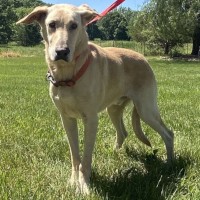Appearance of the Dane Shepherd
|
| The Dane Shepherd will be a combination of the two parent breeds, the Great Dane and the German Shepherd. Although there isn't much information on the Dane Shepherd breed itself, we can study the parent breeds to determine what the Dane Shepherd will look like. The Great Dane has a short, smooth coat. It can come in a variety of six colors: fawn with black mask, brindle, blue, black, harlequin (white with irregular spots all over the body) and mantle (black and white with solid black covering on the body). German Shepherds come in many colors, although the traditional black with beige trim is most often recognized. They can be all black, black and cream, black and tan, blue, gray, liver, sable and white. White German Shepherds are not recognized as an acceptable color under AKC guidelines, but some breeders actually strive for this color. Your Dane Shepherd will be a big dog with a long muzzle and erect ears. Bright brown eyes will alert you to a curious and gentle dog. |
Temperament of the Dane Shepherd
|
| The Great Dane is a gentle giant. It's often considered one of the most natural dogs to have. It is very gentle, affectionate and playful. What's more, they naturally love children. He's easy to train, and wants nothing more than to please his humans. He loves people and wants to interact with his family. The Great Dane often forgets how big he is, so he may try his hand at being a watchdog from time to time. Early socialization is recommended, especially with other animals. While he generally gets on well with other animals, it never hurts to teach him from an early age how to behave and what is expected of him. Some experts even recommend obedience classes for Great Danes. The other parent, the German Shepherd, has a reputation for aggression, much of which is undeserved. He's very alert and reserved with strangers, so he's an excellent watchdog. It takes time for him to make friends, but once he does, he's immensely loyal. He's highly intelligent and easily trained. However, he doesn't do well alone for long periods. He needs the company of his family and is extremely loyal to them. He may bark excessively or chew if bored. Early socialization is also recommended for the German Shepherd. Your Dane Shepherd will be an unfailing, intuitive and highly intelligent companion. Take him to a neighborhood get-together often, so he can show off his people skills and practice them at the same time. |
Needs and activities of the Dane Shepherd
|
| The Dane Shepherd is a fairly active dog. It's recommended that he gets enough exercise to ensure he maintains a healthy weight. He may tend to put on weight if not exposed to regular activity. He tends to do best in a home with a large yard in which he can be allowed to run and play. He may also enjoy joining you for a leisurely stroll. The dog park is an ideal place for the Dane Shepherd, he'll enjoy the opportunity to get out, run and play with other dogs. He needs regular exercise so he doesn't chew or bark excessively. Mental stimulation is also important for this hybrid. An intelligent dog who listens to your wishes, he'll be eager to please but needs interaction and activities that exercise his mind and body. |
Maintenance of the Dane Shepherd
|
| The Great Dane generally has a short, smooth coat. He tends to shed a lot, but with regular brushing, you're unlikely to find much hair on your furniture or clothes. The natural oils in his coat will help him look shiny and clean with regular brushing. You should also maintain regular ear cleaning as part of your maintenance routine. A bad odor or redness could signal an infection. German Shepherds have a medium-length double coat designed to protect their tender skin from snow and rain, but it's also resistant to dirt. Some German Shepherds are long-haired, but in general, they will have a medium-length coat. Sometimes, the German Shepherd's outer coat will be stiff to the touch. He can be prone to shedding as they shed all year round, he will also have a blow in which he has a major shed twice a year. Brush your Dane Shepherd two or three times a week with a smooth bristle brush. He should only be bathed when necessary. It's a good idea to take advantage of the fact that the German Shepherd parent likes to chew, so give your Dane Shepherd chews to keep his teeth clean, in addition to regular brushing and promoting overall dental health. |









 English (United Kingdom)
English (United Kingdom)